Knowledge Management Strategies at Oman Human Rights (Summer 2019)
VerifiedAdded on 2022/11/27
|15
|3716
|444
Report
AI Summary
This report provides a critical analysis of knowledge management within Oman Human Rights, a governmental and non-profit organization. It begins with an introduction to the organization, its structure, and its mission to monitor human rights violations. The report then explores the concept of knowledge management within the organization, focusing on the IT department's functions and the implementation of the "Self-Service" system. It identifies key challenges to effective knowledge management, including communication barriers, data inconsistency, and lack of employee awareness and training. A literature review supports the analysis, examining relevant research on knowledge sharing and management. The methodology includes qualitative and quantitative research, involving interviews and observations. The results highlight the importance of knowledge management, the current practices of knowledge sharing, and the inefficiencies of the existing system. Recommendations are provided, emphasizing the need for improved communication channels, data organization, employee training, and the establishment of a knowledge-sharing culture. The report concludes with a summary of the key findings and suggestions for enhancing knowledge management practices within Oman Human Rights to improve decision-making and operational efficiency.

Running Head: OMAN HUMAN RIGHTS 0
KNOLWEDGE MANAGEMENT
KNOLWEDGE MANAGEMENT
Paraphrase This Document
Need a fresh take? Get an instant paraphrase of this document with our AI Paraphraser
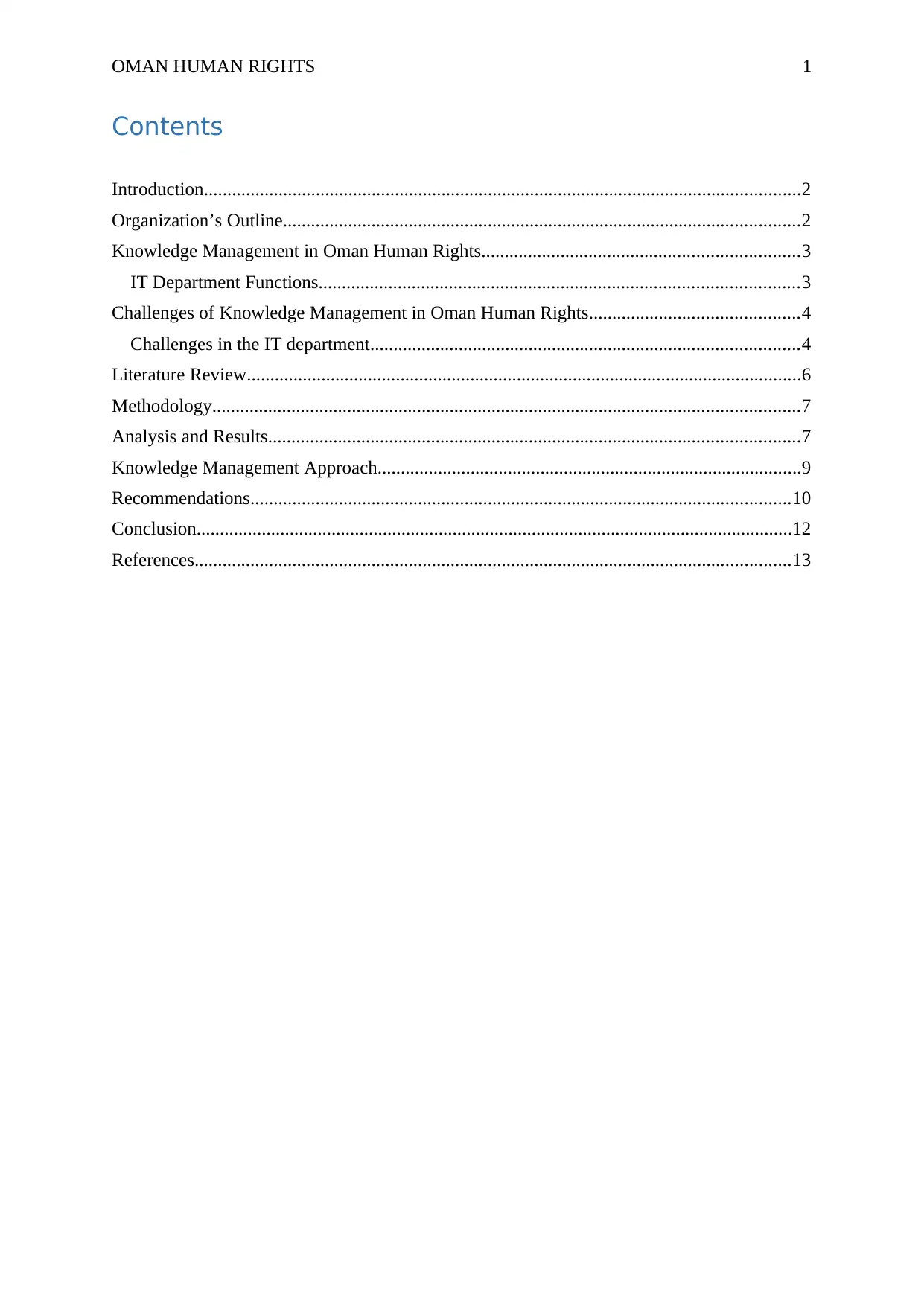
OMAN HUMAN RIGHTS 1
Contents
Introduction................................................................................................................................2
Organization’s Outline...............................................................................................................2
Knowledge Management in Oman Human Rights....................................................................3
IT Department Functions.......................................................................................................3
Challenges of Knowledge Management in Oman Human Rights.............................................4
Challenges in the IT department............................................................................................4
Literature Review.......................................................................................................................6
Methodology..............................................................................................................................7
Analysis and Results..................................................................................................................7
Knowledge Management Approach...........................................................................................9
Recommendations....................................................................................................................10
Conclusion................................................................................................................................12
References................................................................................................................................13
Contents
Introduction................................................................................................................................2
Organization’s Outline...............................................................................................................2
Knowledge Management in Oman Human Rights....................................................................3
IT Department Functions.......................................................................................................3
Challenges of Knowledge Management in Oman Human Rights.............................................4
Challenges in the IT department............................................................................................4
Literature Review.......................................................................................................................6
Methodology..............................................................................................................................7
Analysis and Results..................................................................................................................7
Knowledge Management Approach...........................................................................................9
Recommendations....................................................................................................................10
Conclusion................................................................................................................................12
References................................................................................................................................13
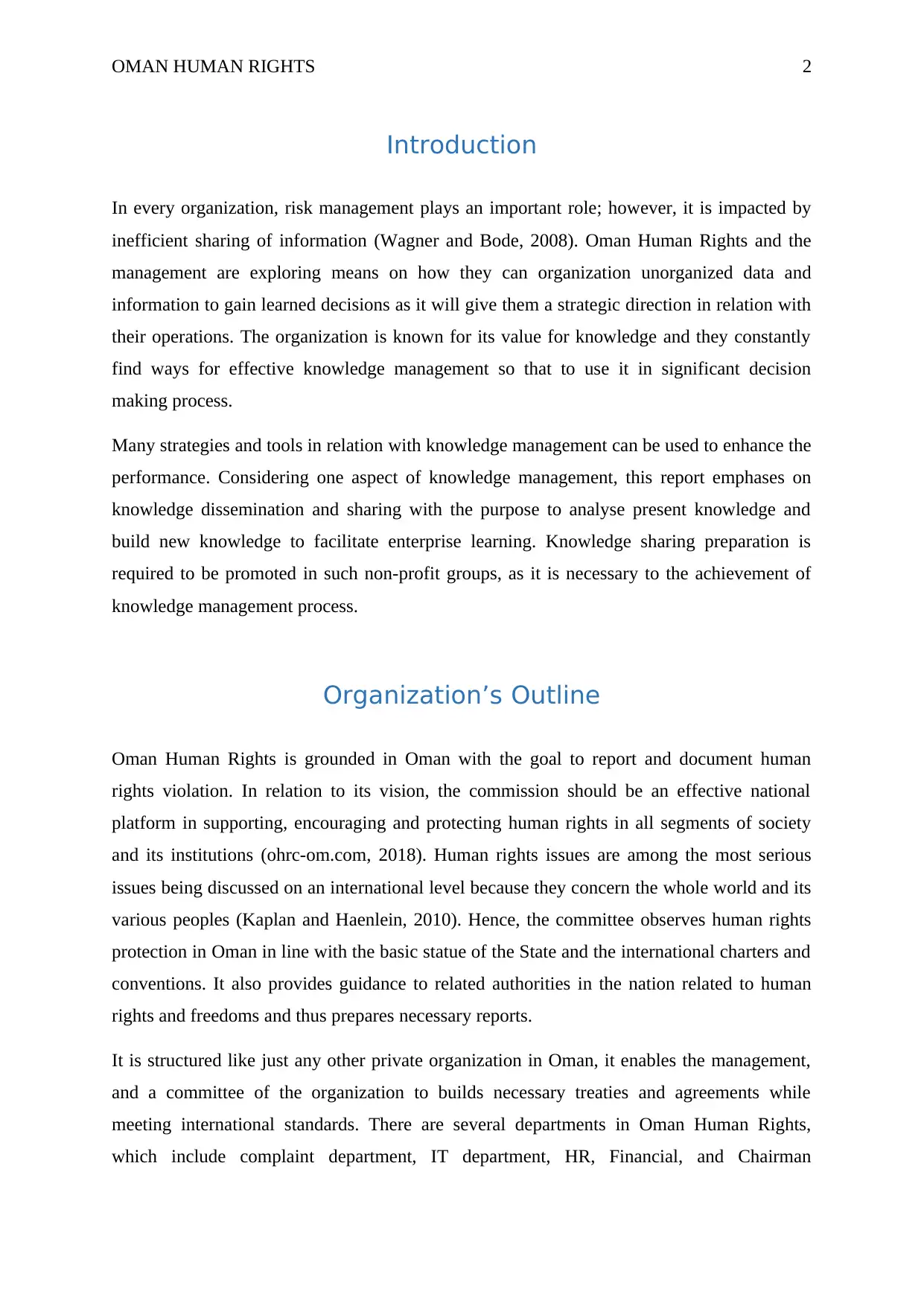
OMAN HUMAN RIGHTS 2
Introduction
In every organization, risk management plays an important role; however, it is impacted by
inefficient sharing of information (Wagner and Bode, 2008). Oman Human Rights and the
management are exploring means on how they can organization unorganized data and
information to gain learned decisions as it will give them a strategic direction in relation with
their operations. The organization is known for its value for knowledge and they constantly
find ways for effective knowledge management so that to use it in significant decision
making process.
Many strategies and tools in relation with knowledge management can be used to enhance the
performance. Considering one aspect of knowledge management, this report emphases on
knowledge dissemination and sharing with the purpose to analyse present knowledge and
build new knowledge to facilitate enterprise learning. Knowledge sharing preparation is
required to be promoted in such non-profit groups, as it is necessary to the achievement of
knowledge management process.
Organization’s Outline
Oman Human Rights is grounded in Oman with the goal to report and document human
rights violation. In relation to its vision, the commission should be an effective national
platform in supporting, encouraging and protecting human rights in all segments of society
and its institutions (ohrc-om.com, 2018). Human rights issues are among the most serious
issues being discussed on an international level because they concern the whole world and its
various peoples (Kaplan and Haenlein, 2010). Hence, the committee observes human rights
protection in Oman in line with the basic statue of the State and the international charters and
conventions. It also provides guidance to related authorities in the nation related to human
rights and freedoms and thus prepares necessary reports.
It is structured like just any other private organization in Oman, it enables the management,
and a committee of the organization to builds necessary treaties and agreements while
meeting international standards. There are several departments in Oman Human Rights,
which include complaint department, IT department, HR, Financial, and Chairman
Introduction
In every organization, risk management plays an important role; however, it is impacted by
inefficient sharing of information (Wagner and Bode, 2008). Oman Human Rights and the
management are exploring means on how they can organization unorganized data and
information to gain learned decisions as it will give them a strategic direction in relation with
their operations. The organization is known for its value for knowledge and they constantly
find ways for effective knowledge management so that to use it in significant decision
making process.
Many strategies and tools in relation with knowledge management can be used to enhance the
performance. Considering one aspect of knowledge management, this report emphases on
knowledge dissemination and sharing with the purpose to analyse present knowledge and
build new knowledge to facilitate enterprise learning. Knowledge sharing preparation is
required to be promoted in such non-profit groups, as it is necessary to the achievement of
knowledge management process.
Organization’s Outline
Oman Human Rights is grounded in Oman with the goal to report and document human
rights violation. In relation to its vision, the commission should be an effective national
platform in supporting, encouraging and protecting human rights in all segments of society
and its institutions (ohrc-om.com, 2018). Human rights issues are among the most serious
issues being discussed on an international level because they concern the whole world and its
various peoples (Kaplan and Haenlein, 2010). Hence, the committee observes human rights
protection in Oman in line with the basic statue of the State and the international charters and
conventions. It also provides guidance to related authorities in the nation related to human
rights and freedoms and thus prepares necessary reports.
It is structured like just any other private organization in Oman, it enables the management,
and a committee of the organization to builds necessary treaties and agreements while
meeting international standards. There are several departments in Oman Human Rights,
which include complaint department, IT department, HR, Financial, and Chairman
⊘ This is a preview!⊘
Do you want full access?
Subscribe today to unlock all pages.

Trusted by 1+ million students worldwide
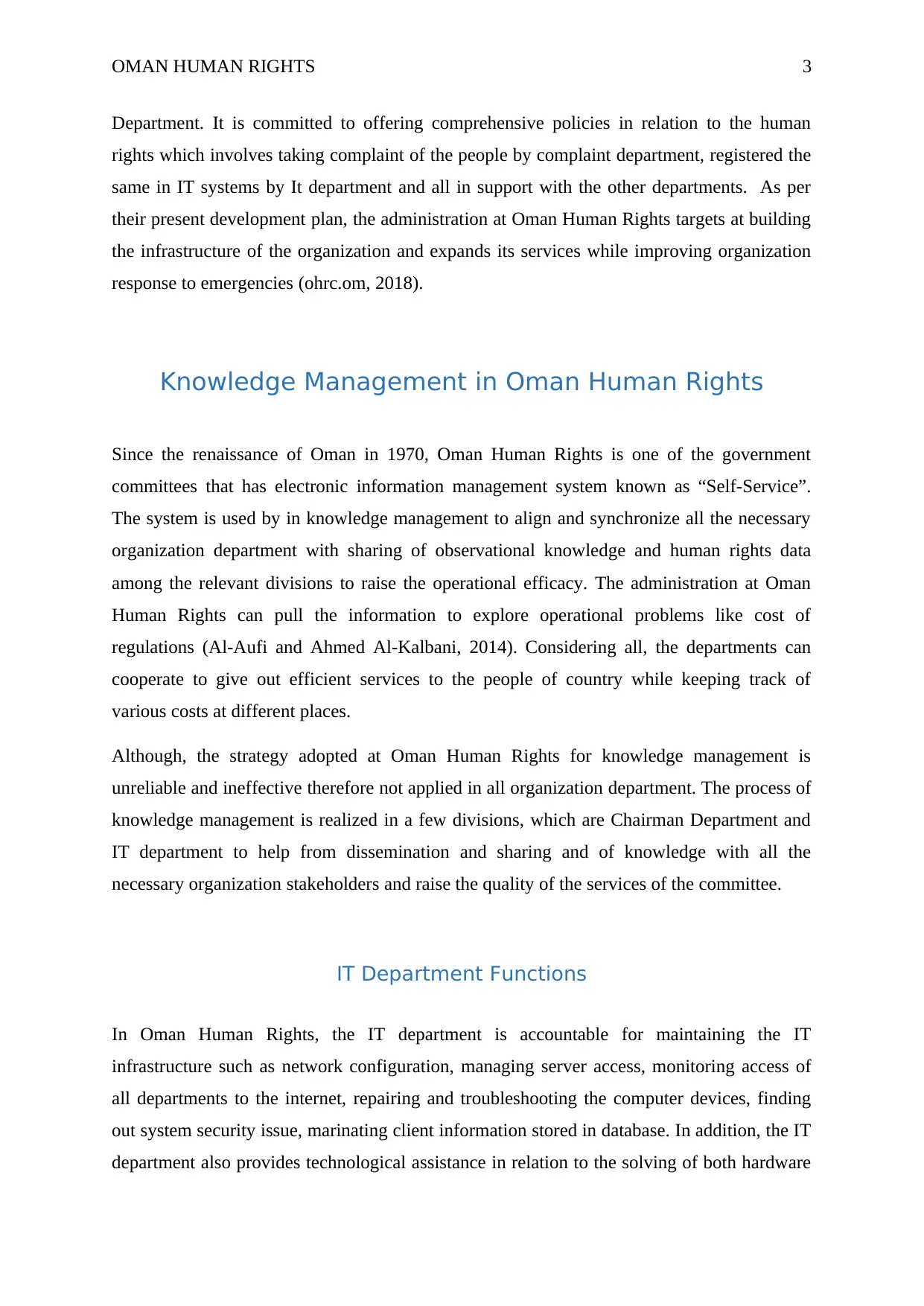
OMAN HUMAN RIGHTS 3
Department. It is committed to offering comprehensive policies in relation to the human
rights which involves taking complaint of the people by complaint department, registered the
same in IT systems by It department and all in support with the other departments. As per
their present development plan, the administration at Oman Human Rights targets at building
the infrastructure of the organization and expands its services while improving organization
response to emergencies (ohrc.om, 2018).
Knowledge Management in Oman Human Rights
Since the renaissance of Oman in 1970, Oman Human Rights is one of the government
committees that has electronic information management system known as “Self-Service”.
The system is used by in knowledge management to align and synchronize all the necessary
organization department with sharing of observational knowledge and human rights data
among the relevant divisions to raise the operational efficacy. The administration at Oman
Human Rights can pull the information to explore operational problems like cost of
regulations (Al-Aufi and Ahmed Al-Kalbani, 2014). Considering all, the departments can
cooperate to give out efficient services to the people of country while keeping track of
various costs at different places.
Although, the strategy adopted at Oman Human Rights for knowledge management is
unreliable and ineffective therefore not applied in all organization department. The process of
knowledge management is realized in a few divisions, which are Chairman Department and
IT department to help from dissemination and sharing and of knowledge with all the
necessary organization stakeholders and raise the quality of the services of the committee.
IT Department Functions
In Oman Human Rights, the IT department is accountable for maintaining the IT
infrastructure such as network configuration, managing server access, monitoring access of
all departments to the internet, repairing and troubleshooting the computer devices, finding
out system security issue, marinating client information stored in database. In addition, the IT
department also provides technological assistance in relation to the solving of both hardware
Department. It is committed to offering comprehensive policies in relation to the human
rights which involves taking complaint of the people by complaint department, registered the
same in IT systems by It department and all in support with the other departments. As per
their present development plan, the administration at Oman Human Rights targets at building
the infrastructure of the organization and expands its services while improving organization
response to emergencies (ohrc.om, 2018).
Knowledge Management in Oman Human Rights
Since the renaissance of Oman in 1970, Oman Human Rights is one of the government
committees that has electronic information management system known as “Self-Service”.
The system is used by in knowledge management to align and synchronize all the necessary
organization department with sharing of observational knowledge and human rights data
among the relevant divisions to raise the operational efficacy. The administration at Oman
Human Rights can pull the information to explore operational problems like cost of
regulations (Al-Aufi and Ahmed Al-Kalbani, 2014). Considering all, the departments can
cooperate to give out efficient services to the people of country while keeping track of
various costs at different places.
Although, the strategy adopted at Oman Human Rights for knowledge management is
unreliable and ineffective therefore not applied in all organization department. The process of
knowledge management is realized in a few divisions, which are Chairman Department and
IT department to help from dissemination and sharing and of knowledge with all the
necessary organization stakeholders and raise the quality of the services of the committee.
IT Department Functions
In Oman Human Rights, the IT department is accountable for maintaining the IT
infrastructure such as network configuration, managing server access, monitoring access of
all departments to the internet, repairing and troubleshooting the computer devices, finding
out system security issue, marinating client information stored in database. In addition, the IT
department also provides technological assistance in relation to the solving of both hardware
Paraphrase This Document
Need a fresh take? Get an instant paraphrase of this document with our AI Paraphraser
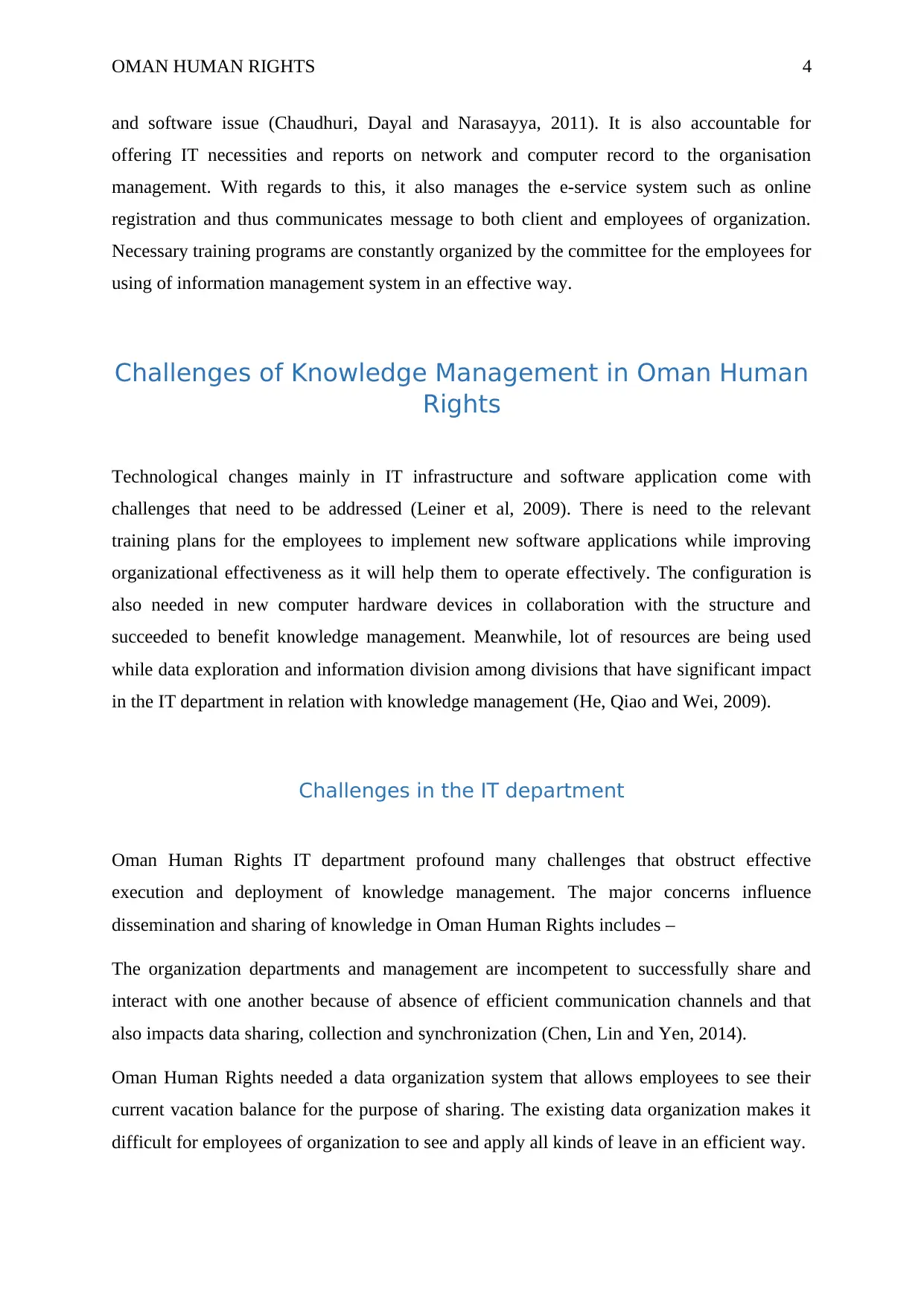
OMAN HUMAN RIGHTS 4
and software issue (Chaudhuri, Dayal and Narasayya, 2011). It is also accountable for
offering IT necessities and reports on network and computer record to the organisation
management. With regards to this, it also manages the e-service system such as online
registration and thus communicates message to both client and employees of organization.
Necessary training programs are constantly organized by the committee for the employees for
using of information management system in an effective way.
Challenges of Knowledge Management in Oman Human
Rights
Technological changes mainly in IT infrastructure and software application come with
challenges that need to be addressed (Leiner et al, 2009). There is need to the relevant
training plans for the employees to implement new software applications while improving
organizational effectiveness as it will help them to operate effectively. The configuration is
also needed in new computer hardware devices in collaboration with the structure and
succeeded to benefit knowledge management. Meanwhile, lot of resources are being used
while data exploration and information division among divisions that have significant impact
in the IT department in relation with knowledge management (He, Qiao and Wei, 2009).
Challenges in the IT department
Oman Human Rights IT department profound many challenges that obstruct effective
execution and deployment of knowledge management. The major concerns influence
dissemination and sharing of knowledge in Oman Human Rights includes –
The organization departments and management are incompetent to successfully share and
interact with one another because of absence of efficient communication channels and that
also impacts data sharing, collection and synchronization (Chen, Lin and Yen, 2014).
Oman Human Rights needed a data organization system that allows employees to see their
current vacation balance for the purpose of sharing. The existing data organization makes it
difficult for employees of organization to see and apply all kinds of leave in an efficient way.
and software issue (Chaudhuri, Dayal and Narasayya, 2011). It is also accountable for
offering IT necessities and reports on network and computer record to the organisation
management. With regards to this, it also manages the e-service system such as online
registration and thus communicates message to both client and employees of organization.
Necessary training programs are constantly organized by the committee for the employees for
using of information management system in an effective way.
Challenges of Knowledge Management in Oman Human
Rights
Technological changes mainly in IT infrastructure and software application come with
challenges that need to be addressed (Leiner et al, 2009). There is need to the relevant
training plans for the employees to implement new software applications while improving
organizational effectiveness as it will help them to operate effectively. The configuration is
also needed in new computer hardware devices in collaboration with the structure and
succeeded to benefit knowledge management. Meanwhile, lot of resources are being used
while data exploration and information division among divisions that have significant impact
in the IT department in relation with knowledge management (He, Qiao and Wei, 2009).
Challenges in the IT department
Oman Human Rights IT department profound many challenges that obstruct effective
execution and deployment of knowledge management. The major concerns influence
dissemination and sharing of knowledge in Oman Human Rights includes –
The organization departments and management are incompetent to successfully share and
interact with one another because of absence of efficient communication channels and that
also impacts data sharing, collection and synchronization (Chen, Lin and Yen, 2014).
Oman Human Rights needed a data organization system that allows employees to see their
current vacation balance for the purpose of sharing. The existing data organization makes it
difficult for employees of organization to see and apply all kinds of leave in an efficient way.
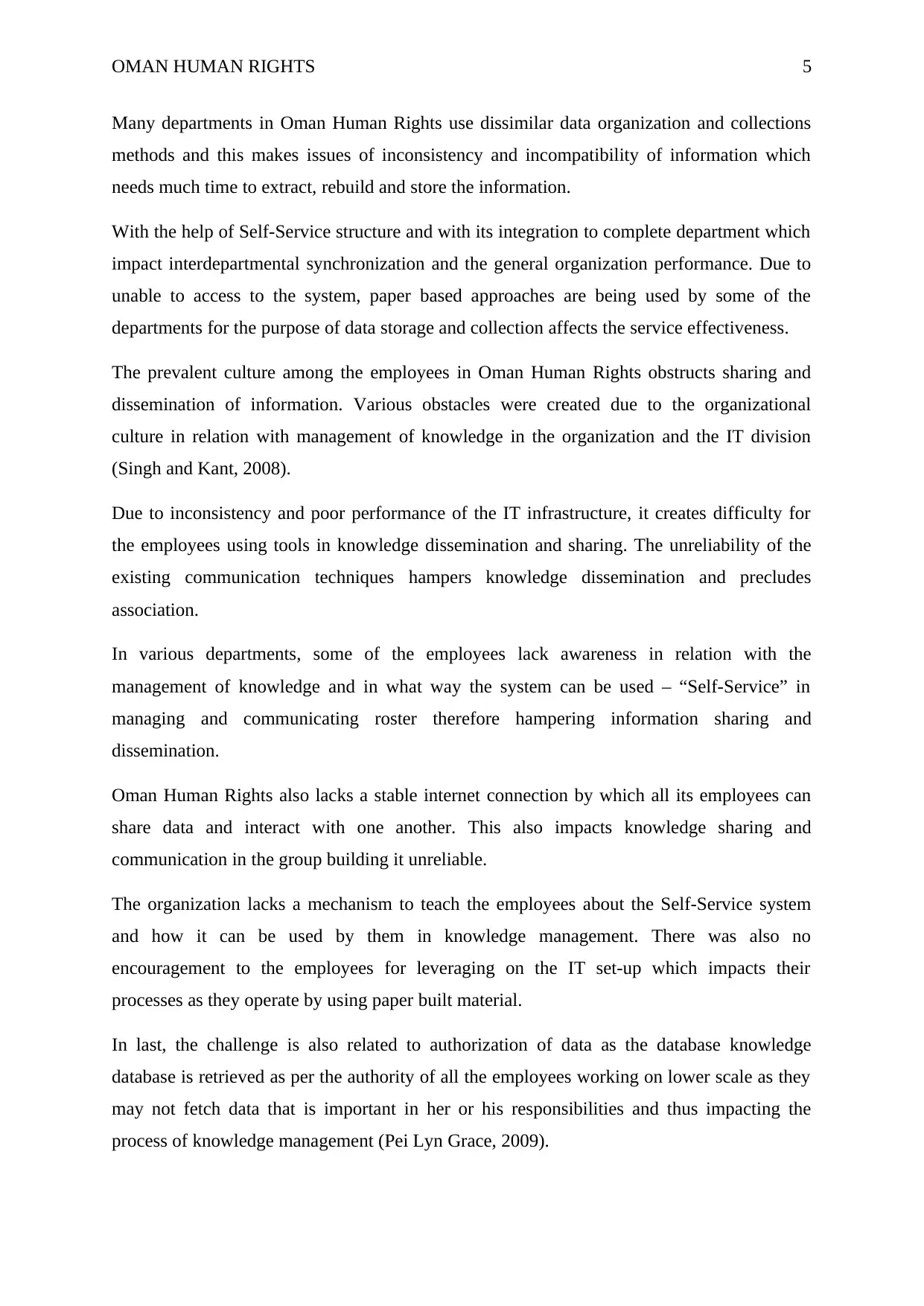
OMAN HUMAN RIGHTS 5
Many departments in Oman Human Rights use dissimilar data organization and collections
methods and this makes issues of inconsistency and incompatibility of information which
needs much time to extract, rebuild and store the information.
With the help of Self-Service structure and with its integration to complete department which
impact interdepartmental synchronization and the general organization performance. Due to
unable to access to the system, paper based approaches are being used by some of the
departments for the purpose of data storage and collection affects the service effectiveness.
The prevalent culture among the employees in Oman Human Rights obstructs sharing and
dissemination of information. Various obstacles were created due to the organizational
culture in relation with management of knowledge in the organization and the IT division
(Singh and Kant, 2008).
Due to inconsistency and poor performance of the IT infrastructure, it creates difficulty for
the employees using tools in knowledge dissemination and sharing. The unreliability of the
existing communication techniques hampers knowledge dissemination and precludes
association.
In various departments, some of the employees lack awareness in relation with the
management of knowledge and in what way the system can be used – “Self-Service” in
managing and communicating roster therefore hampering information sharing and
dissemination.
Oman Human Rights also lacks a stable internet connection by which all its employees can
share data and interact with one another. This also impacts knowledge sharing and
communication in the group building it unreliable.
The organization lacks a mechanism to teach the employees about the Self-Service system
and how it can be used by them in knowledge management. There was also no
encouragement to the employees for leveraging on the IT set-up which impacts their
processes as they operate by using paper built material.
In last, the challenge is also related to authorization of data as the database knowledge
database is retrieved as per the authority of all the employees working on lower scale as they
may not fetch data that is important in her or his responsibilities and thus impacting the
process of knowledge management (Pei Lyn Grace, 2009).
Many departments in Oman Human Rights use dissimilar data organization and collections
methods and this makes issues of inconsistency and incompatibility of information which
needs much time to extract, rebuild and store the information.
With the help of Self-Service structure and with its integration to complete department which
impact interdepartmental synchronization and the general organization performance. Due to
unable to access to the system, paper based approaches are being used by some of the
departments for the purpose of data storage and collection affects the service effectiveness.
The prevalent culture among the employees in Oman Human Rights obstructs sharing and
dissemination of information. Various obstacles were created due to the organizational
culture in relation with management of knowledge in the organization and the IT division
(Singh and Kant, 2008).
Due to inconsistency and poor performance of the IT infrastructure, it creates difficulty for
the employees using tools in knowledge dissemination and sharing. The unreliability of the
existing communication techniques hampers knowledge dissemination and precludes
association.
In various departments, some of the employees lack awareness in relation with the
management of knowledge and in what way the system can be used – “Self-Service” in
managing and communicating roster therefore hampering information sharing and
dissemination.
Oman Human Rights also lacks a stable internet connection by which all its employees can
share data and interact with one another. This also impacts knowledge sharing and
communication in the group building it unreliable.
The organization lacks a mechanism to teach the employees about the Self-Service system
and how it can be used by them in knowledge management. There was also no
encouragement to the employees for leveraging on the IT set-up which impacts their
processes as they operate by using paper built material.
In last, the challenge is also related to authorization of data as the database knowledge
database is retrieved as per the authority of all the employees working on lower scale as they
may not fetch data that is important in her or his responsibilities and thus impacting the
process of knowledge management (Pei Lyn Grace, 2009).
⊘ This is a preview!⊘
Do you want full access?
Subscribe today to unlock all pages.

Trusted by 1+ million students worldwide
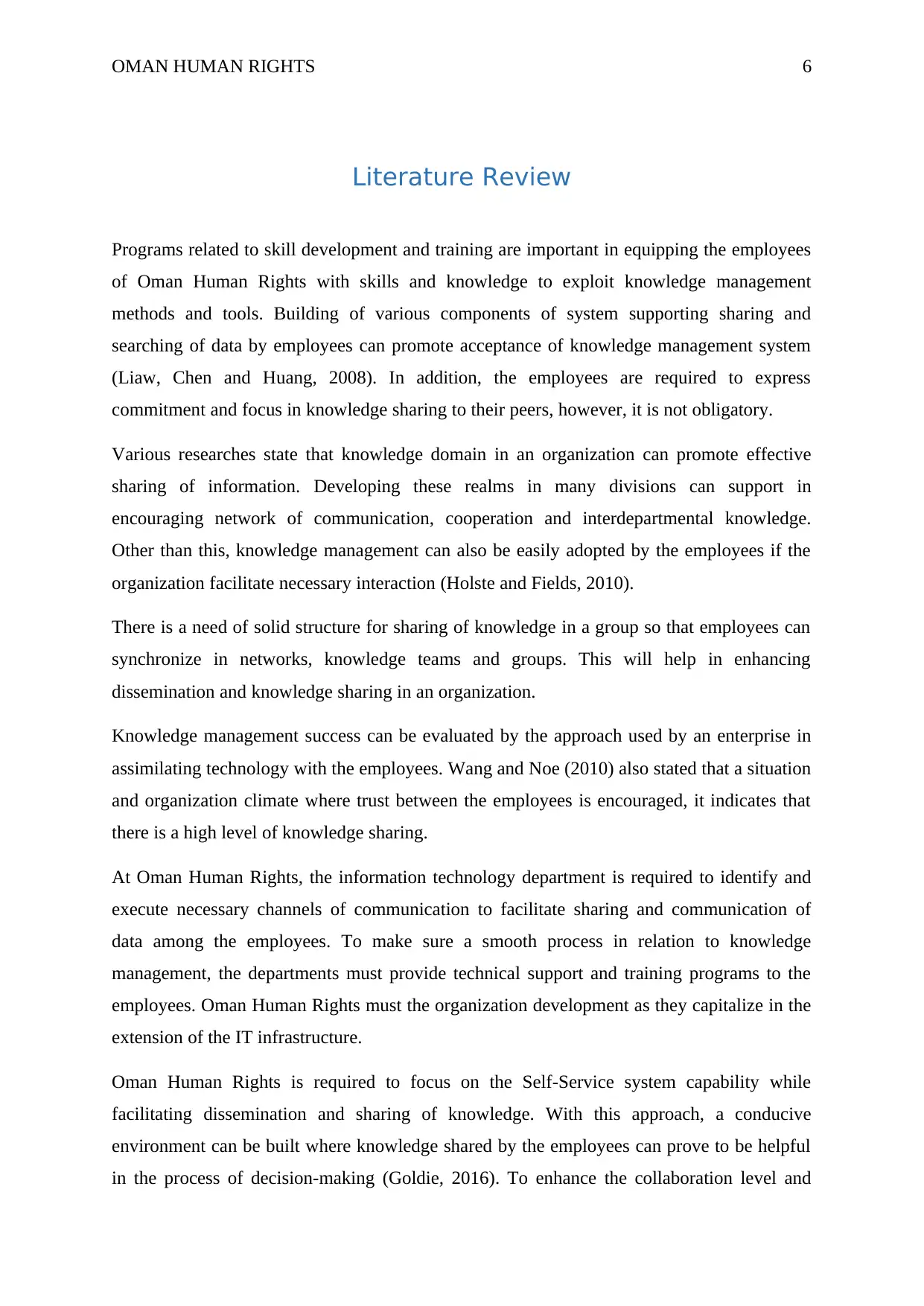
OMAN HUMAN RIGHTS 6
Literature Review
Programs related to skill development and training are important in equipping the employees
of Oman Human Rights with skills and knowledge to exploit knowledge management
methods and tools. Building of various components of system supporting sharing and
searching of data by employees can promote acceptance of knowledge management system
(Liaw, Chen and Huang, 2008). In addition, the employees are required to express
commitment and focus in knowledge sharing to their peers, however, it is not obligatory.
Various researches state that knowledge domain in an organization can promote effective
sharing of information. Developing these realms in many divisions can support in
encouraging network of communication, cooperation and interdepartmental knowledge.
Other than this, knowledge management can also be easily adopted by the employees if the
organization facilitate necessary interaction (Holste and Fields, 2010).
There is a need of solid structure for sharing of knowledge in a group so that employees can
synchronize in networks, knowledge teams and groups. This will help in enhancing
dissemination and knowledge sharing in an organization.
Knowledge management success can be evaluated by the approach used by an enterprise in
assimilating technology with the employees. Wang and Noe (2010) also stated that a situation
and organization climate where trust between the employees is encouraged, it indicates that
there is a high level of knowledge sharing.
At Oman Human Rights, the information technology department is required to identify and
execute necessary channels of communication to facilitate sharing and communication of
data among the employees. To make sure a smooth process in relation to knowledge
management, the departments must provide technical support and training programs to the
employees. Oman Human Rights must the organization development as they capitalize in the
extension of the IT infrastructure.
Oman Human Rights is required to focus on the Self-Service system capability while
facilitating dissemination and sharing of knowledge. With this approach, a conducive
environment can be built where knowledge shared by the employees can prove to be helpful
in the process of decision-making (Goldie, 2016). To enhance the collaboration level and
Literature Review
Programs related to skill development and training are important in equipping the employees
of Oman Human Rights with skills and knowledge to exploit knowledge management
methods and tools. Building of various components of system supporting sharing and
searching of data by employees can promote acceptance of knowledge management system
(Liaw, Chen and Huang, 2008). In addition, the employees are required to express
commitment and focus in knowledge sharing to their peers, however, it is not obligatory.
Various researches state that knowledge domain in an organization can promote effective
sharing of information. Developing these realms in many divisions can support in
encouraging network of communication, cooperation and interdepartmental knowledge.
Other than this, knowledge management can also be easily adopted by the employees if the
organization facilitate necessary interaction (Holste and Fields, 2010).
There is a need of solid structure for sharing of knowledge in a group so that employees can
synchronize in networks, knowledge teams and groups. This will help in enhancing
dissemination and knowledge sharing in an organization.
Knowledge management success can be evaluated by the approach used by an enterprise in
assimilating technology with the employees. Wang and Noe (2010) also stated that a situation
and organization climate where trust between the employees is encouraged, it indicates that
there is a high level of knowledge sharing.
At Oman Human Rights, the information technology department is required to identify and
execute necessary channels of communication to facilitate sharing and communication of
data among the employees. To make sure a smooth process in relation to knowledge
management, the departments must provide technical support and training programs to the
employees. Oman Human Rights must the organization development as they capitalize in the
extension of the IT infrastructure.
Oman Human Rights is required to focus on the Self-Service system capability while
facilitating dissemination and sharing of knowledge. With this approach, a conducive
environment can be built where knowledge shared by the employees can prove to be helpful
in the process of decision-making (Goldie, 2016). To enhance the collaboration level and
Paraphrase This Document
Need a fresh take? Get an instant paraphrase of this document with our AI Paraphraser
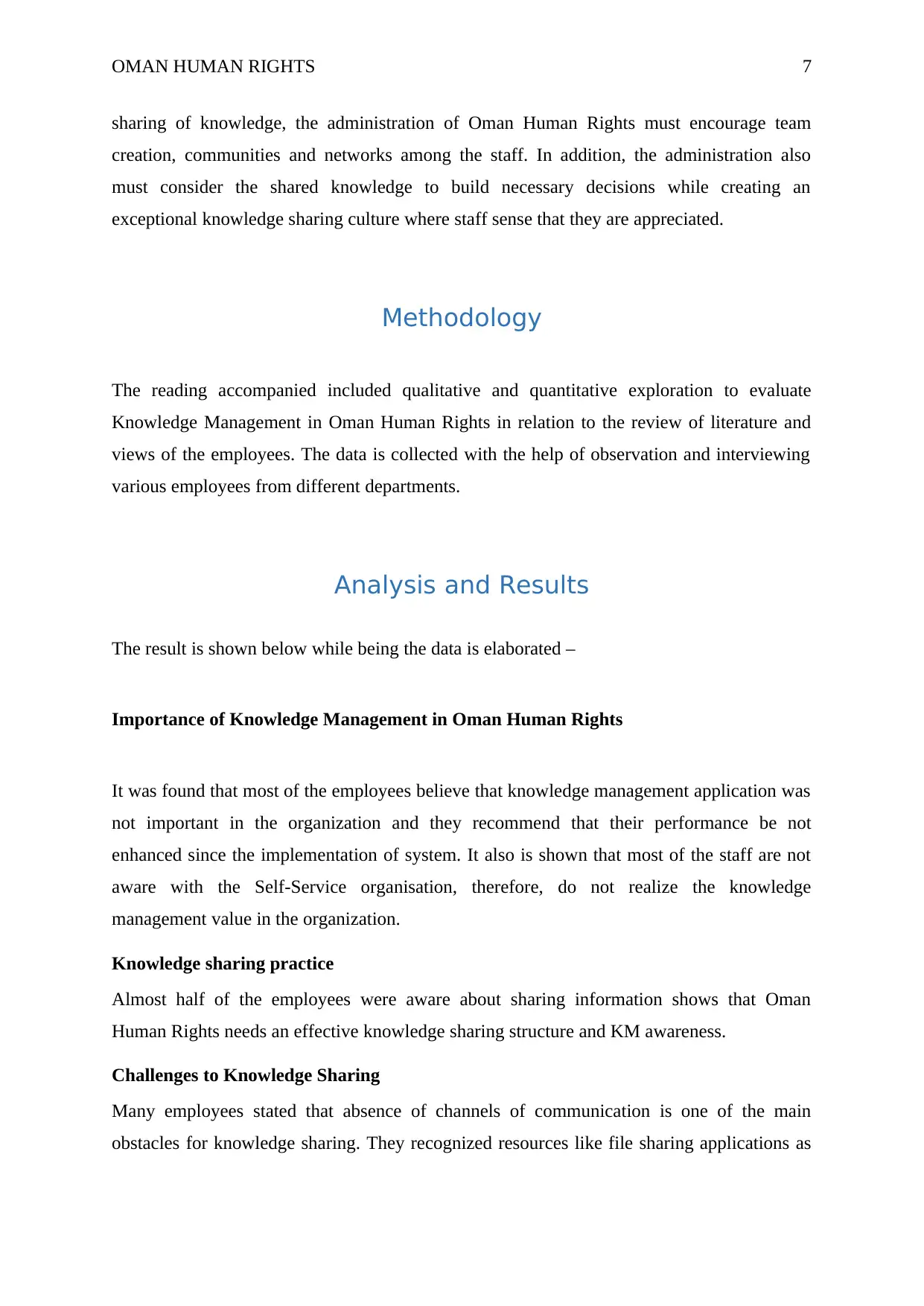
OMAN HUMAN RIGHTS 7
sharing of knowledge, the administration of Oman Human Rights must encourage team
creation, communities and networks among the staff. In addition, the administration also
must consider the shared knowledge to build necessary decisions while creating an
exceptional knowledge sharing culture where staff sense that they are appreciated.
Methodology
The reading accompanied included qualitative and quantitative exploration to evaluate
Knowledge Management in Oman Human Rights in relation to the review of literature and
views of the employees. The data is collected with the help of observation and interviewing
various employees from different departments.
Analysis and Results
The result is shown below while being the data is elaborated –
Importance of Knowledge Management in Oman Human Rights
It was found that most of the employees believe that knowledge management application was
not important in the organization and they recommend that their performance be not
enhanced since the implementation of system. It also is shown that most of the staff are not
aware with the Self-Service organisation, therefore, do not realize the knowledge
management value in the organization.
Knowledge sharing practice
Almost half of the employees were aware about sharing information shows that Oman
Human Rights needs an effective knowledge sharing structure and KM awareness.
Challenges to Knowledge Sharing
Many employees stated that absence of channels of communication is one of the main
obstacles for knowledge sharing. They recognized resources like file sharing applications as
sharing of knowledge, the administration of Oman Human Rights must encourage team
creation, communities and networks among the staff. In addition, the administration also
must consider the shared knowledge to build necessary decisions while creating an
exceptional knowledge sharing culture where staff sense that they are appreciated.
Methodology
The reading accompanied included qualitative and quantitative exploration to evaluate
Knowledge Management in Oman Human Rights in relation to the review of literature and
views of the employees. The data is collected with the help of observation and interviewing
various employees from different departments.
Analysis and Results
The result is shown below while being the data is elaborated –
Importance of Knowledge Management in Oman Human Rights
It was found that most of the employees believe that knowledge management application was
not important in the organization and they recommend that their performance be not
enhanced since the implementation of system. It also is shown that most of the staff are not
aware with the Self-Service organisation, therefore, do not realize the knowledge
management value in the organization.
Knowledge sharing practice
Almost half of the employees were aware about sharing information shows that Oman
Human Rights needs an effective knowledge sharing structure and KM awareness.
Challenges to Knowledge Sharing
Many employees stated that absence of channels of communication is one of the main
obstacles for knowledge sharing. They recognized resources like file sharing applications as
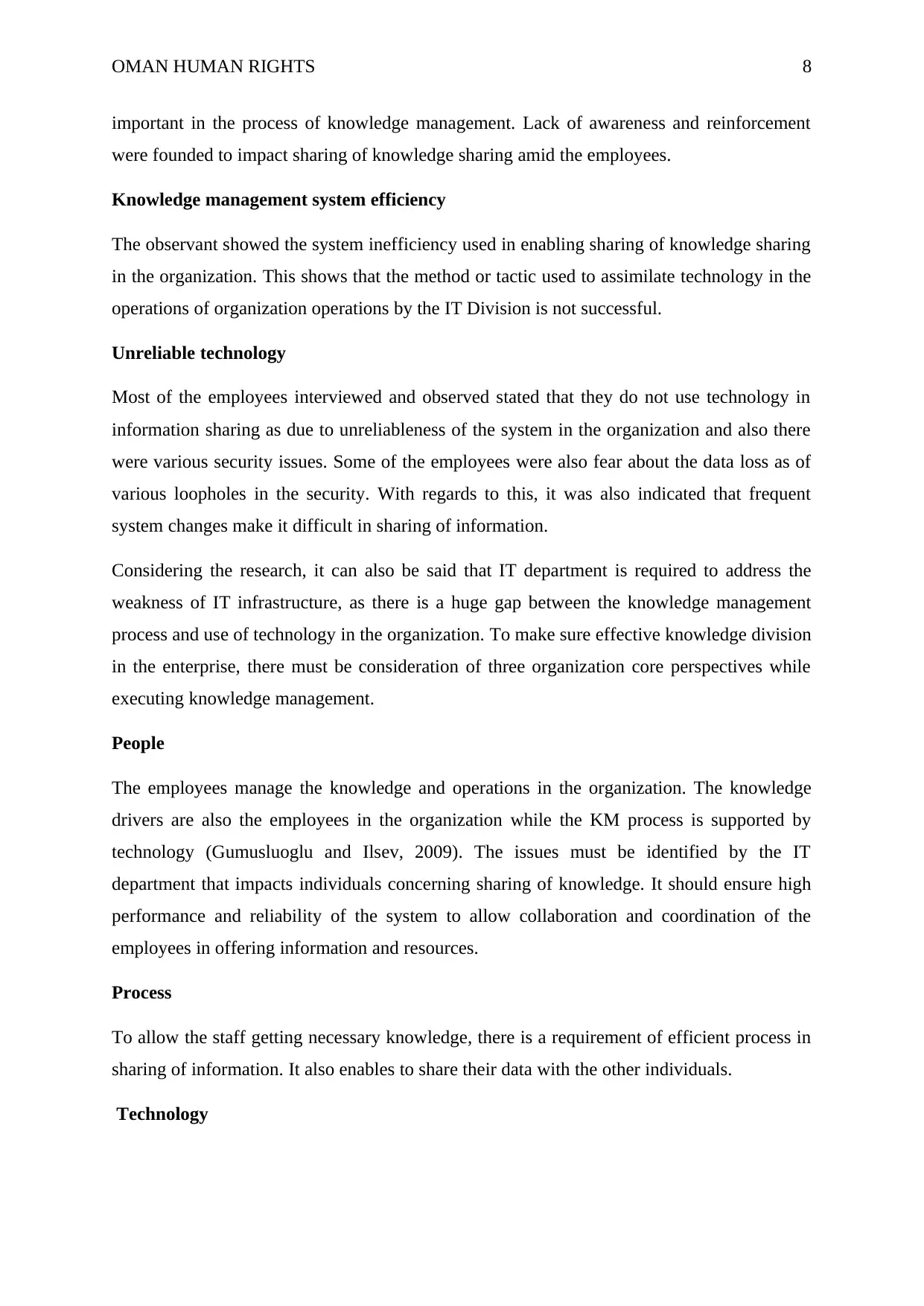
OMAN HUMAN RIGHTS 8
important in the process of knowledge management. Lack of awareness and reinforcement
were founded to impact sharing of knowledge sharing amid the employees.
Knowledge management system efficiency
The observant showed the system inefficiency used in enabling sharing of knowledge sharing
in the organization. This shows that the method or tactic used to assimilate technology in the
operations of organization operations by the IT Division is not successful.
Unreliable technology
Most of the employees interviewed and observed stated that they do not use technology in
information sharing as due to unreliableness of the system in the organization and also there
were various security issues. Some of the employees were also fear about the data loss as of
various loopholes in the security. With regards to this, it was also indicated that frequent
system changes make it difficult in sharing of information.
Considering the research, it can also be said that IT department is required to address the
weakness of IT infrastructure, as there is a huge gap between the knowledge management
process and use of technology in the organization. To make sure effective knowledge division
in the enterprise, there must be consideration of three organization core perspectives while
executing knowledge management.
People
The employees manage the knowledge and operations in the organization. The knowledge
drivers are also the employees in the organization while the KM process is supported by
technology (Gumusluoglu and Ilsev, 2009). The issues must be identified by the IT
department that impacts individuals concerning sharing of knowledge. It should ensure high
performance and reliability of the system to allow collaboration and coordination of the
employees in offering information and resources.
Process
To allow the staff getting necessary knowledge, there is a requirement of efficient process in
sharing of information. It also enables to share their data with the other individuals.
Technology
important in the process of knowledge management. Lack of awareness and reinforcement
were founded to impact sharing of knowledge sharing amid the employees.
Knowledge management system efficiency
The observant showed the system inefficiency used in enabling sharing of knowledge sharing
in the organization. This shows that the method or tactic used to assimilate technology in the
operations of organization operations by the IT Division is not successful.
Unreliable technology
Most of the employees interviewed and observed stated that they do not use technology in
information sharing as due to unreliableness of the system in the organization and also there
were various security issues. Some of the employees were also fear about the data loss as of
various loopholes in the security. With regards to this, it was also indicated that frequent
system changes make it difficult in sharing of information.
Considering the research, it can also be said that IT department is required to address the
weakness of IT infrastructure, as there is a huge gap between the knowledge management
process and use of technology in the organization. To make sure effective knowledge division
in the enterprise, there must be consideration of three organization core perspectives while
executing knowledge management.
People
The employees manage the knowledge and operations in the organization. The knowledge
drivers are also the employees in the organization while the KM process is supported by
technology (Gumusluoglu and Ilsev, 2009). The issues must be identified by the IT
department that impacts individuals concerning sharing of knowledge. It should ensure high
performance and reliability of the system to allow collaboration and coordination of the
employees in offering information and resources.
Process
To allow the staff getting necessary knowledge, there is a requirement of efficient process in
sharing of information. It also enables to share their data with the other individuals.
Technology
⊘ This is a preview!⊘
Do you want full access?
Subscribe today to unlock all pages.

Trusted by 1+ million students worldwide
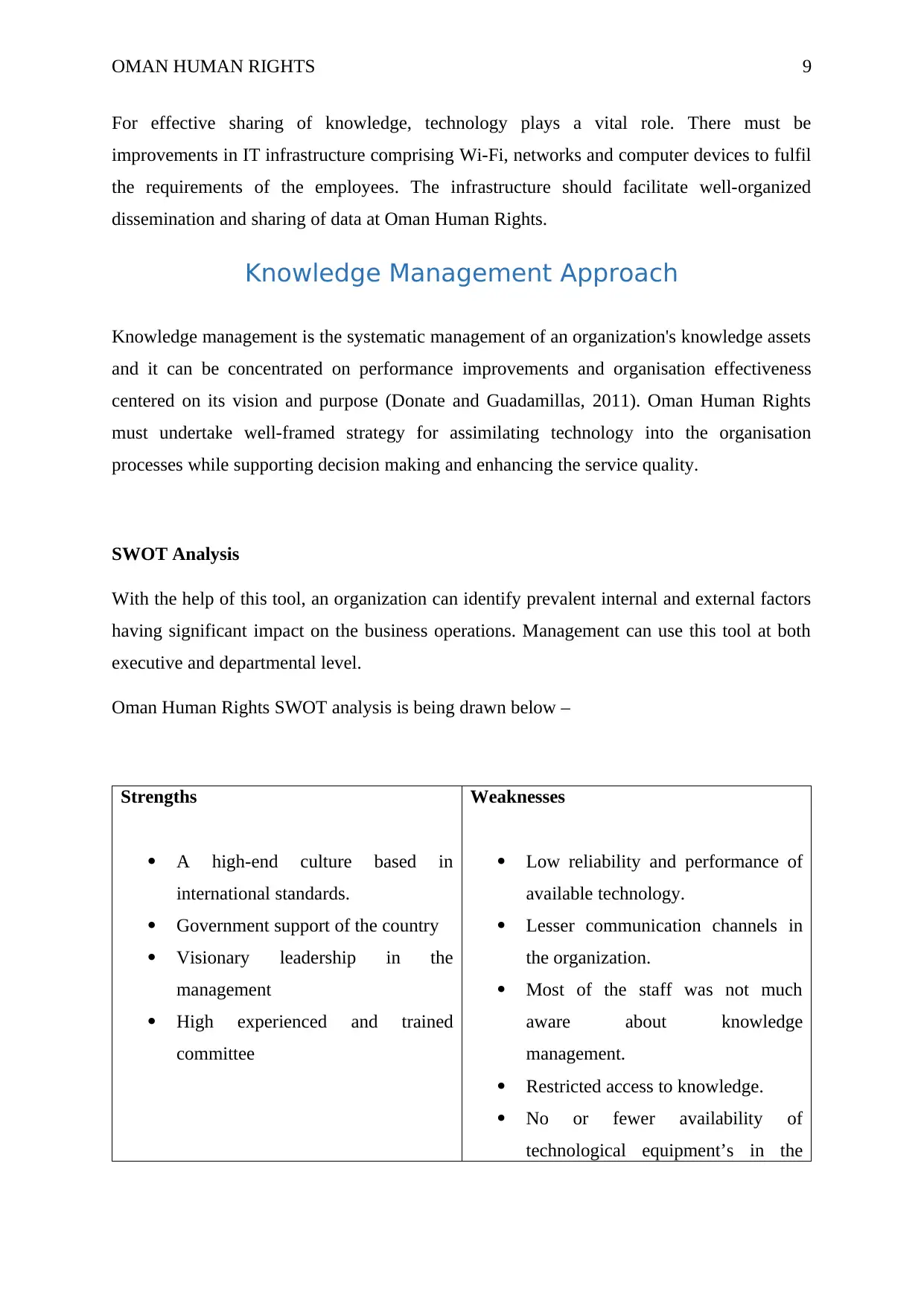
OMAN HUMAN RIGHTS 9
For effective sharing of knowledge, technology plays a vital role. There must be
improvements in IT infrastructure comprising Wi-Fi, networks and computer devices to fulfil
the requirements of the employees. The infrastructure should facilitate well-organized
dissemination and sharing of data at Oman Human Rights.
Knowledge Management Approach
Knowledge management is the systematic management of an organization's knowledge assets
and it can be concentrated on performance improvements and organisation effectiveness
centered on its vision and purpose (Donate and Guadamillas, 2011). Oman Human Rights
must undertake well-framed strategy for assimilating technology into the organisation
processes while supporting decision making and enhancing the service quality.
SWOT Analysis
With the help of this tool, an organization can identify prevalent internal and external factors
having significant impact on the business operations. Management can use this tool at both
executive and departmental level.
Oman Human Rights SWOT analysis is being drawn below –
Strengths
A high-end culture based in
international standards.
Government support of the country
Visionary leadership in the
management
High experienced and trained
committee
Weaknesses
Low reliability and performance of
available technology.
Lesser communication channels in
the organization.
Most of the staff was not much
aware about knowledge
management.
Restricted access to knowledge.
No or fewer availability of
technological equipment’s in the
For effective sharing of knowledge, technology plays a vital role. There must be
improvements in IT infrastructure comprising Wi-Fi, networks and computer devices to fulfil
the requirements of the employees. The infrastructure should facilitate well-organized
dissemination and sharing of data at Oman Human Rights.
Knowledge Management Approach
Knowledge management is the systematic management of an organization's knowledge assets
and it can be concentrated on performance improvements and organisation effectiveness
centered on its vision and purpose (Donate and Guadamillas, 2011). Oman Human Rights
must undertake well-framed strategy for assimilating technology into the organisation
processes while supporting decision making and enhancing the service quality.
SWOT Analysis
With the help of this tool, an organization can identify prevalent internal and external factors
having significant impact on the business operations. Management can use this tool at both
executive and departmental level.
Oman Human Rights SWOT analysis is being drawn below –
Strengths
A high-end culture based in
international standards.
Government support of the country
Visionary leadership in the
management
High experienced and trained
committee
Weaknesses
Low reliability and performance of
available technology.
Lesser communication channels in
the organization.
Most of the staff was not much
aware about knowledge
management.
Restricted access to knowledge.
No or fewer availability of
technological equipment’s in the
Paraphrase This Document
Need a fresh take? Get an instant paraphrase of this document with our AI Paraphraser
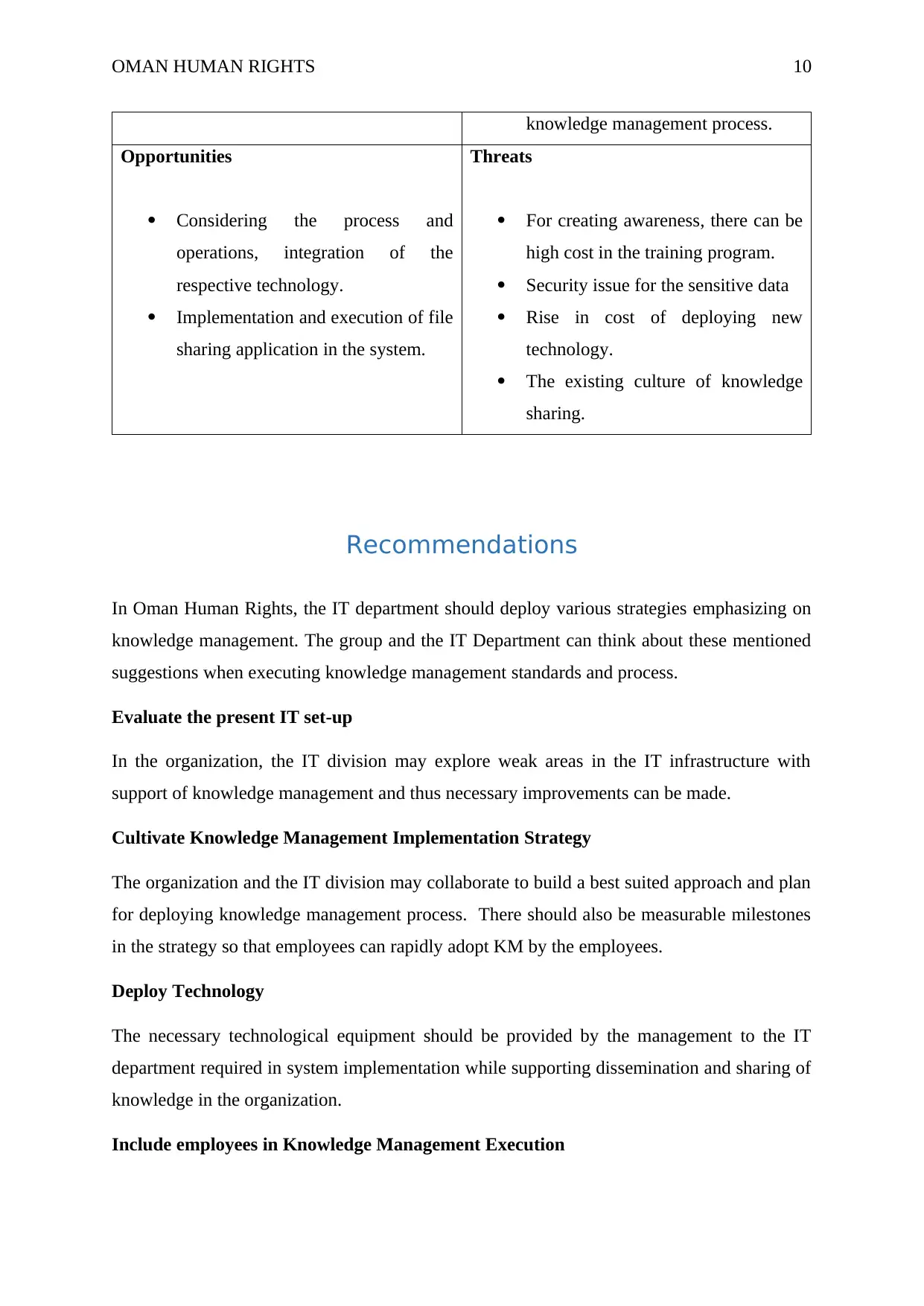
OMAN HUMAN RIGHTS 10
knowledge management process.
Opportunities
Considering the process and
operations, integration of the
respective technology.
Implementation and execution of file
sharing application in the system.
Threats
For creating awareness, there can be
high cost in the training program.
Security issue for the sensitive data
Rise in cost of deploying new
technology.
The existing culture of knowledge
sharing.
Recommendations
In Oman Human Rights, the IT department should deploy various strategies emphasizing on
knowledge management. The group and the IT Department can think about these mentioned
suggestions when executing knowledge management standards and process.
Evaluate the present IT set-up
In the organization, the IT division may explore weak areas in the IT infrastructure with
support of knowledge management and thus necessary improvements can be made.
Cultivate Knowledge Management Implementation Strategy
The organization and the IT division may collaborate to build a best suited approach and plan
for deploying knowledge management process. There should also be measurable milestones
in the strategy so that employees can rapidly adopt KM by the employees.
Deploy Technology
The necessary technological equipment should be provided by the management to the IT
department required in system implementation while supporting dissemination and sharing of
knowledge in the organization.
Include employees in Knowledge Management Execution
knowledge management process.
Opportunities
Considering the process and
operations, integration of the
respective technology.
Implementation and execution of file
sharing application in the system.
Threats
For creating awareness, there can be
high cost in the training program.
Security issue for the sensitive data
Rise in cost of deploying new
technology.
The existing culture of knowledge
sharing.
Recommendations
In Oman Human Rights, the IT department should deploy various strategies emphasizing on
knowledge management. The group and the IT Department can think about these mentioned
suggestions when executing knowledge management standards and process.
Evaluate the present IT set-up
In the organization, the IT division may explore weak areas in the IT infrastructure with
support of knowledge management and thus necessary improvements can be made.
Cultivate Knowledge Management Implementation Strategy
The organization and the IT division may collaborate to build a best suited approach and plan
for deploying knowledge management process. There should also be measurable milestones
in the strategy so that employees can rapidly adopt KM by the employees.
Deploy Technology
The necessary technological equipment should be provided by the management to the IT
department required in system implementation while supporting dissemination and sharing of
knowledge in the organization.
Include employees in Knowledge Management Execution
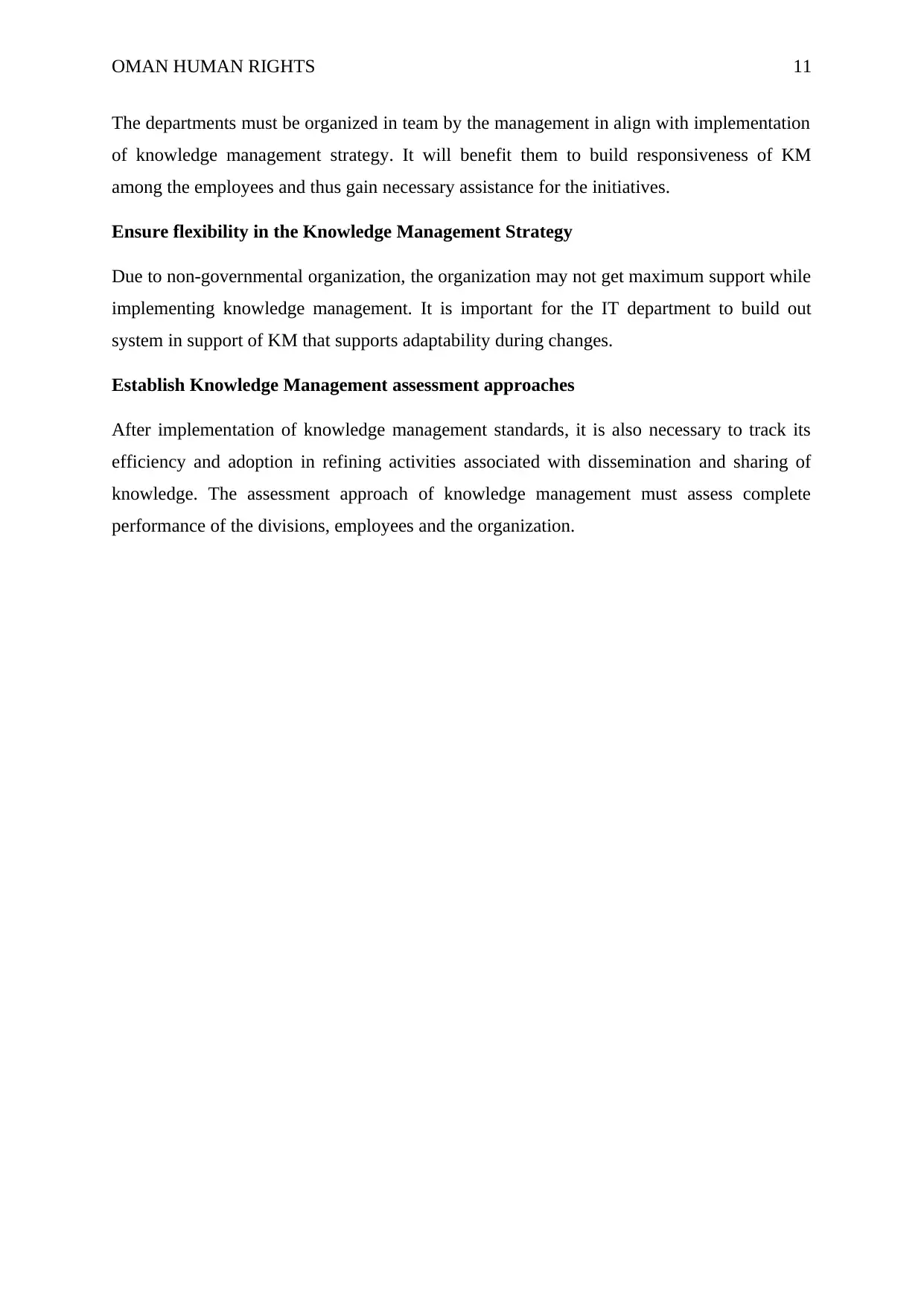
OMAN HUMAN RIGHTS 11
The departments must be organized in team by the management in align with implementation
of knowledge management strategy. It will benefit them to build responsiveness of KM
among the employees and thus gain necessary assistance for the initiatives.
Ensure flexibility in the Knowledge Management Strategy
Due to non-governmental organization, the organization may not get maximum support while
implementing knowledge management. It is important for the IT department to build out
system in support of KM that supports adaptability during changes.
Establish Knowledge Management assessment approaches
After implementation of knowledge management standards, it is also necessary to track its
efficiency and adoption in refining activities associated with dissemination and sharing of
knowledge. The assessment approach of knowledge management must assess complete
performance of the divisions, employees and the organization.
The departments must be organized in team by the management in align with implementation
of knowledge management strategy. It will benefit them to build responsiveness of KM
among the employees and thus gain necessary assistance for the initiatives.
Ensure flexibility in the Knowledge Management Strategy
Due to non-governmental organization, the organization may not get maximum support while
implementing knowledge management. It is important for the IT department to build out
system in support of KM that supports adaptability during changes.
Establish Knowledge Management assessment approaches
After implementation of knowledge management standards, it is also necessary to track its
efficiency and adoption in refining activities associated with dissemination and sharing of
knowledge. The assessment approach of knowledge management must assess complete
performance of the divisions, employees and the organization.
⊘ This is a preview!⊘
Do you want full access?
Subscribe today to unlock all pages.

Trusted by 1+ million students worldwide
1 out of 15
Related Documents
Your All-in-One AI-Powered Toolkit for Academic Success.
+13062052269
info@desklib.com
Available 24*7 on WhatsApp / Email
![[object Object]](/_next/static/media/star-bottom.7253800d.svg)
Unlock your academic potential
Copyright © 2020–2025 A2Z Services. All Rights Reserved. Developed and managed by ZUCOL.




